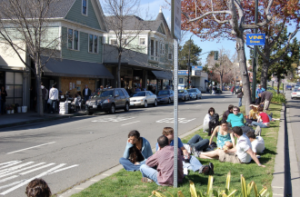On Social Architecture: Democracy, Design, and New Networks with Eric McDougall
Laura Belik on the Arts + Design Mondays @ BAMPFA | Public (Re)Assembly talk series
On Social Architecture: Democracy, Design, and New Networks with Eric McDougall on April 23, 2018
 Eric McDougall, designer and advisor for tech companies and artists across the Bay Area, adopts the term “Social Architecture” trying to make connections between design strategies and their interactions with the world around them. After graduating from the College of Environmental Design at UC Berkeley, McDougall’s experience with music and set design brought him to work closer with this industry. As he explains, eventually video took over much of the space of live stage concerts, and that was when the designer started pursuing graphic works more intensively. This range of skills lead him to work as a contractor for multiple companies within Silicon Valley, making story-telling and business presentations to turn into a creative concept through design. “It became more than being a stage set designer, a producer or a creative director…” McDougall recalled.
Eric McDougall, designer and advisor for tech companies and artists across the Bay Area, adopts the term “Social Architecture” trying to make connections between design strategies and their interactions with the world around them. After graduating from the College of Environmental Design at UC Berkeley, McDougall’s experience with music and set design brought him to work closer with this industry. As he explains, eventually video took over much of the space of live stage concerts, and that was when the designer started pursuing graphic works more intensively. This range of skills lead him to work as a contractor for multiple companies within Silicon Valley, making story-telling and business presentations to turn into a creative concept through design. “It became more than being a stage set designer, a producer or a creative director…” McDougall recalled.
After working with these series of tech companies, McDougall finally had the opportunity of being at one of them, hired as the “Minister of Cool” at Zynga HQ. His job now as an “insider” was to change the entire branding of the company, including its headquarters’ space. At this time, he also learned about the digital ad business and this also opened doors for him to start working with other retail employers as well.
 These spatial experiences brought McDougall back to a more architectonical practice, making him reflect on what makes it a good space, and what he considered to be “Social Architecture”. Some of McDougall’s social architecture qualities are related to simple thoughtful designs across from what he calls the “stack”, a multi-layer map combining what he believes the spaces are, and how they are perceived. Public social spaces are, for him, key elements to be considered. The architect also emphasizes the role of “accidental” spaces, places that became perceived as such through their spontaneous uses. Finally, McDougall reflected upon the role of technology in today’s “stack”, and how this is potentially a space to disrupt current layers, since it influences and perceives design differently. What and how are our physical spaces perceived within the digital world? What is the role of design in this transition? These are some of the questions yet to be solved. But as McDougal reminds us, social architecture is about people, and part of the solution should be to keep that in mind at all times.
These spatial experiences brought McDougall back to a more architectonical practice, making him reflect on what makes it a good space, and what he considered to be “Social Architecture”. Some of McDougall’s social architecture qualities are related to simple thoughtful designs across from what he calls the “stack”, a multi-layer map combining what he believes the spaces are, and how they are perceived. Public social spaces are, for him, key elements to be considered. The architect also emphasizes the role of “accidental” spaces, places that became perceived as such through their spontaneous uses. Finally, McDougall reflected upon the role of technology in today’s “stack”, and how this is potentially a space to disrupt current layers, since it influences and perceives design differently. What and how are our physical spaces perceived within the digital world? What is the role of design in this transition? These are some of the questions yet to be solved. But as McDougal reminds us, social architecture is about people, and part of the solution should be to keep that in mind at all times.
Laura Belik (PhD Student, Architecture) reviewed the April 23rd talk, On Social Architecture: Democracy, Design, and New Networks, as part of the Spring 2018 Arts + Design Mondays @ BAMPFA series. To learn more about the series, see below:
What is the role of public assembly in our current moment? And to what degree are new models necessary to respond artistically and technologically to our political climate? After a highly successful launch of Arts + Design Mondays @ BAMPFA in Spring 2017, Berkeley Arts + Design is pleased to present a new suite of exciting lectures that explore the theme of “public (re) assembly” from a variety of perspectives. The word assembly carries a range of associations. It challenges us to think about the democratic right to assemble; it recalls the artistic history of assemblage. It provokes us to imagine new systems of arrangement that respond to a digital age. It asks to consider how UC Berkeley might re-imagine the “school assembly” as a site of social transformation. Learn more here.
